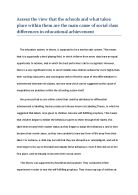Two educational policies which increased the duration of school stay could also be considered as reducing social class inequality. First in 1918 when the compulsory leaving age was raised to 14, and then again in 1972 when attendance was made compulsory up until 16. This could be interpreted as providing class equality as it is allowing those from deprived backgrounds to stay on at school for longer, learn more, and in the end come out with more qualifications than they would have leaving at a younger age. Thus this then allows them to find better paid occupations, rather than gaining employment in some of the most exploitative jobs capitalism has to offer.
Compensatory education has helped to promote class equality. In order to overcome material deprivation, recent governments have introduced a number of schemes that aim to compensate those from lower social backgrounds. Schemes include EMA and free school meals. Obviously, the middle class children will not have to worry about money or paying for things, as their parents can pay for everything. However, working class children aren’t as financially well off. This often means that they have to work part time in order to support their studies, which in turn effects their education, as they can’t spend valuable time studying and doing homework. So in order to reduce money issues and allow children to focus on their education, giving them the same chance as middle class children, EMA was introduced for households on under £30,000 p.a. and free school meals made available. This meant that children could receive a weekly payment whilst studying for their A levels.
The introduction of academy schools in 2000 by Tony Blair is also an example of educational policy reducing social class inequality. The academies were established in order to drive up standards by replacing failing schools in struggling education authorities. Inevitably, the previous failing schools would have been attended by working class children, so the academies gave them a chance to improve their education. A report by PWC in July 2007 found attainment in academies is improving at a faster rate than comparable schools and the national average and pupils are doing better overall at key stage 3, GCSE and post-16 levels. Therefore, the academies can be said to be successful in their aim of “driving up standards,” and have introduced class equality, as now more working class children are able to attend university due to the qualifications gained by attending the academy schools.
A couple of policies introduced by the New Labour Government in 1997 have also tackled social class inequality. One of these is the pumping of extra resources into EAZ’s (Education Action Zones). EAZ’s are specially designated areas in England that are considered for special assistance in increasing the quality or availability of educational opportunities. Therefore if more resources are being pumped in, it means they are able to have the same calibre of facilities as private schools, such as interactive white boards, computer suites etc. The second policy introduced by the New Labour Government was the abolishment of Grant-maintained schools. Labour did not like the way that they ‘creamed’ the brightest students.
The Education Reform Act of 1988 welcomed the marketization of education. This helped to improve class equality as the standards of education were raised by introducing competition between schools. Therefore if a school was failing, they would bring in head teachers from the business world in order to manage the finances of the school and help invest money into resources. This would give the working class children a better learning environment whilst attending school, which would hopefully boost their education attainment. However, there was a problem. Schools with better reputations because of being higher up in the league tables attracted more pupils. This provided them with more money. Consequently, less funding was provided to the schools that needed it most. This created ‘sink schools’ – many of which were closed down.
A final educational policy introduced with the main aim of reducing social class inequality was the Assisted Places Scheme. The Assisted Places Scheme was established in the by the government in 1980. Children who could not afford to go to fee-paying were provided with free or subsidised places - if they were able to score within the top 10-15% of applicants in the school's entrance examination. By 1985, the scheme catered for some 6,000 students per year. This is clearly a policy that helped to improve class equality, as placements at top schools were based on reward and merit, rather on finance, something which the working class lack.
Overall, over the past century there have been many policies which have helped to reduce social class inequality. However, it isn’t always positive. For example, the replacement of grants with loans may have deterred working-class students from entering higher education, as those from poorer backgrounds are more likely to fear getting into debt. In addition, there are many factors that can affect educational achievement outside of the classroom, such as problems at home. Educational policies can only help to improve educational experiences within school, and are not always successful (e.g. Marketization of education).







